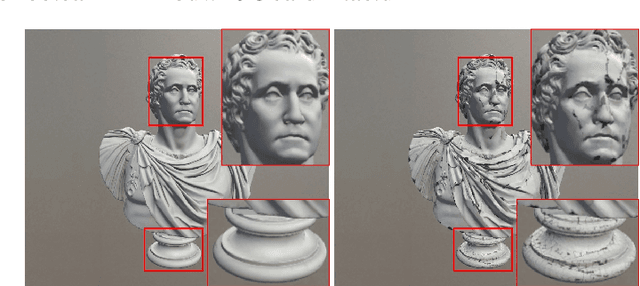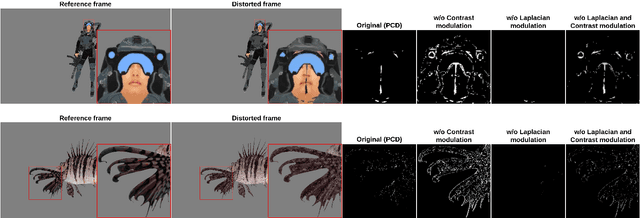Armin Shafiee Sarvestani
HybridMQA: Exploring Geometry-Texture Interactions for Colored Mesh Quality Assessment
Dec 02, 2024Abstract:Mesh quality assessment (MQA) models play a critical role in the design, optimization, and evaluation of mesh operation systems in a wide variety of applications. Current MQA models, whether model-based methods using topology-aware features or projection-based approaches working on rendered 2D projections, often fail to capture the intricate interactions between texture and 3D geometry. We introduce HybridMQA, a first-of-its-kind hybrid full-reference colored MQA framework that integrates model-based and projection-based approaches, capturing complex interactions between textural information and 3D structures for enriched quality representations. Our method employs graph learning to extract detailed 3D representations, which are then projected to 2D using a novel feature rendering process that precisely aligns them with colored projections. This enables the exploration of geometry-texture interactions via cross-attention, producing comprehensive mesh quality representations. Extensive experiments demonstrate HybridMQA's superior performance across diverse datasets, highlighting its ability to effectively leverage geometry-texture interactions for a thorough understanding of mesh quality. Our implementation will be made publicly available.
Perceptual Crack Detection for Rendered 3D Textured Meshes
May 09, 2024



Abstract:Recent years have witnessed many advancements in the applications of 3D textured meshes. As the demand continues to rise, evaluating the perceptual quality of this new type of media content becomes crucial for quality assurance and optimization purposes. Different from traditional image quality assessment, crack is an annoying artifact specific to rendered 3D meshes that severely affects their perceptual quality. In this work, we make one of the first attempts to propose a novel Perceptual Crack Detection (PCD) method for detecting and localizing crack artifacts in rendered meshes. Specifically, motivated by the characteristics of the human visual system (HVS), we adopt contrast and Laplacian measurement modules to characterize crack artifacts and differentiate them from other undesired artifacts. Extensive experiments on large-scale public datasets of 3D textured meshes demonstrate effectiveness and efficiency of the proposed PCD method in correct localization and detection of crack artifacts. %Specifically, We propose a full-reference crack artifact localization method that operates on a pair of input snapshots of distorted and reference 3D objects to generate a final crack map. Moreover, to quantify the performance of the proposed detection method and validate its effectiveness, we propose a simple yet effective weighting mechanism to incorporate the resulting crack map into classical quality assessment (QA) models, which creates significant performance improvement in predicting the perceptual image quality when tested on public datasets of static 3D textured meshes. A software release of the proposed method is publicly available at: https://github.com/arshafiee/crack-detection-VVM
 Add to Chrome
Add to Chrome Add to Firefox
Add to Firefox Add to Edge
Add to Edge